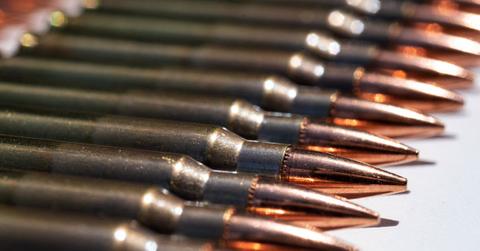Stun Gun: China Unveils High-Speed 'Dream Bullet' That Changes Directions Via Instructions Sent by Satellite

The "dream bullet" can adjust its flight path.
Jan. 27 2024, Published 9:19 a.m. ET
Chinese scientists have reportedly brought to life the "dream bullet," a concept initially conceived by the United States Navy.
This groundbreaking ammunition has the ability to continuously alter its flight path based on satellite instructions.
Scientist Feng Junhong, working with the National Key Laboratory of Electromagnetic Energy at the Naval University of Engineering in China, spearheaded the development of this revolutionary military component.
The bullets, capable of curving their trajectory and adjusting their flight path, represent a leap from science fiction to reality, with potential implications that could reshape the landscape of warfare.
In an era marked by heightened global tensions, the advancement of sophisticated weaponry carries far-reaching consequences, potentially triggering a domino effect on global politics. The South China Morning Post reports that the advanced "dream bullet" can achieve a speed of Mach 7, covering an impressive distance of 8,200 feet per second.
Designed to be fired from an electromagnetic gun, the bullet receives navigation signals from the BeiDou Navigation Satellite constellation operated by the China National Space Administration. While adapting its flight path, the ammunition maintains an error margin of only 49 feet until it reaches its target.
The development of this bullet posed significant challenges, particularly in relation to the navigation system. The launch generated a powerful electromagnetic field capable of damaging the delicate chips and antennas installed.
Feng and his team addressed this issue, proposing a potential solution in a paper published in the Journal of Naval University of Engineering in November 2023.
- Arms Race: US Prepares Test of Hypersonic Missile Capable of Reaching 15,000 Mph After Launch from Space
- World War III? Russia Reportedly Testing Intercontinental Ballistic Nuclear Missiles That Could Strike Any Part of the United States
- Putin Super-Weapon Program in Peril? Multiple Russian Scientists Linked to Hypersonic Missile Program Arrested
The scientists discussed the internal structure of the signal receiver installed in the bullet, emphasizing its ability to withstand forces exceeding 25,000 times that of Earth's gravity during launch.
The South China Morning Post reported that any flaw in its construction, such as disconnections in wire interfaces, could divert the shell off course. Additionally, the intense heat generated due to friction during flight was countered by using a cost-effective, mass-produced aerogel as a thermal barrier.
Never miss a story — sign up for the Front Page Detectives newsletter. Be on the scene the moment news breaks.
Aerogel, known for its potent heat-insulating capabilities, is also utilized for developing cost-effective and lightweight thermal wear for extreme cold situations.
The team implemented a “straightforward, yet potent, algorithm” to ensure uninterrupted satellite communication throughout the bullet's trajectory, considering the erratic swaying during flight, especially when altering course in varying air densities.
Feng mentioned in the paper that while the U.S. was ahead in the bullet's development, they did not share their research with China, leaving the Chinese team to overcome obstacles independently.
Become a Front Page Detective
Sign up to receive breaking
Front Page Detectives
news and exclusive investigations.
